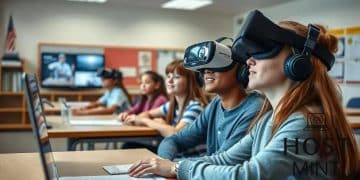How teachers are using AI to reduce workload effectively

Teachers are using AI to reduce workload by automating tasks like grading and lesson planning, allowing for personalized student engagement and enhancing overall educational efficiency.
How teachers are using AI to reduce workload is a game changer in today’s classrooms. Imagine a world where grading and lesson planning take less time, giving educators more opportunities to connect with students. Interested in how this technology can reshape teaching?
Overview of AI technologies for education
As AI technologies continue to advance, they are making significant impacts on education. Understanding these technologies is essential for teachers who want to enhance their teaching methods. This overview will highlight key AI tools that are revolutionizing the classroom experience.
Types of AI Technologies in Education
Educational institutions are increasingly adopting AI solutions. These technologies can perform various tasks, making the process easier for both teachers and students.
- Intelligent Tutoring Systems (ITS): These systems adapt to individual students’ needs, providing personalized learning experiences.
- Grading Automation: Software that can evaluate essays and assignments, saving teachers countless hours.
- Learning Analytics: AI tools analyze student performance data to identify learning patterns and challenges.
Another exciting area is the use of AI in virtual classrooms. Tools that allow for interactive learning environments have gained popularity. They make lessons more engaging, allowing students to participate actively.
Enhancing Classroom Management
AI can also assist teachers with classroom management. From scheduling to resource allocation, these tools optimize the learning environment. By implementing AI solutions, teachers can focus more on teaching and less on administrative tasks.
It’s important to note that technology should complement teaching rather than replace it. With AI, educators can refine their methods, providing more tailored support to students.
This integration of AI in educational settings encourages teachers to embrace innovation. By understanding and utilizing these tools, they can create enriched experiences that foster student learning.
Overall, the overview of AI technologies for education reveals promising possibilities. As educators become familiar with these advancements, they open doors to new teaching strategies that can truly benefit students.
Time-saving applications for teachers

Time-saving applications for teachers are essential tools in today’s fast-paced educational environment. These technologies help streamline various tasks, allowing educators to focus more on teaching and less on paperwork.
Popular Applications That Save Time
With numerous options available, it can be challenging to choose the right tools. Here are some popular applications that teachers find particularly effective:
- Gradebook Software: Programs that simplify the grading process and help manage student performance.
- Lesson Planning Tools: Platforms that assist in organizing and planning lessons efficiently.
- Communication Apps: Tools for quick communication with students and parents, reducing back-and-forth emails.
Many teachers report that using these applications not only saves them time but also enhances their productivity. Instead of spending hours on administrative tasks, they can invest that time into personalized student interactions.
Integrating Technology into Daily Routines
Implementing time-saving applications is about finding the right balance. Teachers can start small by integrating one tool at a time into their daily routines.
This gradual integration helps them adapt without becoming overwhelmed. For example, using a grading app can streamline assignment evaluations. Once teachers feel comfortable, they can explore other applications to manage lesson plans or student communications.
Ultimately, the goal is to create a more efficient workflow that benefits both teachers and their students. Embracing technology is not just about saving time; it’s about enhancing the overall educational experience.
Teachers equipped with the right tools can make teaching more enjoyable and effective. By focusing less on administrative duties and more on student learning, they contribute to a better classroom environment.
Enhancing student engagement through AI
Enhancing student engagement through AI is becoming increasingly important in modern classrooms. With the help of AI, teachers can create interactive experiences that truly captivate their students.
Interactive Learning Tools
One way AI enhances engagement is through interactive learning tools. These tools offer personalized content that adapts to each student’s learning pace and style.
- Gamified Learning: Incorporating games into lessons can boost motivation and excitement.
- Virtual Reality (VR): VR can transport students to different places, making lessons come alive.
- Chatbots: Students can ask questions anytime and receive instant feedback, keeping them engaged even outside class hours.
This technology allows for a more dynamic classroom atmosphere. By incorporating these tools, learning becomes more relevant and appealing to students across various subjects.
Real-Time Feedback and Adaptation
Another key advantage of using AI in education is the ability to provide real-time feedback. Teachers can monitor student progress and adjust lessons as needed.
AI systems can analyze student data to identify areas where they are struggling. This helps educators tailor their approaches, focusing on what individual students need the most. The responsiveness of AI helps to maintain student interest and encourages them to engage more deeply with the material.
Furthermore, lessons can be adjusted on the fly based on class engagement levels. If a particular topic sparks interest, teachers can expand on it instantly, leading to richer discussions.
Utilizing AI this way can create a responsive learning environment. Students are more likely to participate when they feel their needs and interests are acknowledged.
Overall, the potential for enhancing student engagement through AI is vast. As education continues to evolve, teachers can leverage these technologies to not only educate but also inspire their students.
Challenges teachers face with AI adoption
Challenges teachers face with AI adoption are significant as schools integrate technology into the classroom. While AI presents exciting opportunities, many educators encounter hurdles as they try to incorporate it effectively.
Resistance to Change
One major challenge is the resistance to change. Some teachers are accustomed to traditional teaching methods and may fear that technology will complicate their roles.
- Comfort Zone: Many educators may feel unsure about using new tools, preferring familiar practices.
- Concerns About Effectiveness: Some believe that AI cannot adequately replace personal teaching methods.
- Lack of Time for Training: Teachers often have tight schedules, leaving little room for learning new technologies.
Overcoming this resistance is crucial for successful adoption. Providing personalized training can help ease educators into using AI tools.
Technical Issues
Another challenge includes technical problems that may arise during implementation. Issues such as outdated hardware or software can hinder the effective use of AI.
Moreover, teachers may not have immediate access to technical support. This can lead to frustration and a reluctance to utilize AI resources in the classroom.
Improving technology infrastructure is essential. Schools need to invest in suitable equipment and reliable internet access to facilitate smoother AI integration.
Additionally, ongoing professional development can address many concerns, helping teachers discover how to leverage AI for their specific curricular needs.
As educators navigate the challenges of AI adoption, it’s vital to foster a supportive environment that encourages experimentation and growth. Building a community that shares experiences can enhance confidence and foster collaboration among staff.
Future trends in AI for education
Future trends in AI for education are shaping how learning will evolve in the coming years. As technology continues to advance, we can expect several exciting developments that will enhance the educational experience.
Personalized Learning Experiences
One of the most promising trends is the growth of personalized learning through AI. This technology enables tailored educational experiences that cater to individual student needs.
- Adaptive Learning Technologies: These systems adjust content and difficulty based on a student’s progress, ensuring they are always challenged at the right level.
- Learning Analytics: Using data, teachers can understand each student’s strengths and weaknesses, allowing for more focused instruction.
- Customized Feedback: AI can provide immediate feedback to students, helping them improve in real time.
Such personalization can lead to a more engaging learning environment, making education more effective for everyone involved.
Increased Use of Immersive Technologies
Another significant trend is the adoption of immersive technologies such as virtual reality (VR) and augmented reality (AR). These tools provide interactive simulations that make learning more dynamic and engaging.
For example, students can explore historical events or scientific concepts in an immersive setting, enhancing their understanding through experience rather than traditional lectures.
Moreover, these technologies can appeal to diverse learning styles. Students who struggle with conventional methods might excel when they engage with material in a more interactive way.
As these trends in AI for education continue to develop, we can anticipate a shift towards more integrated and technology-driven classrooms. This evolution is likely to not only improve student engagement but also deepen the learning experience as a whole, preparing students for a future where technology is ever-present in their lives.
FAQ – Frequently Asked Questions about AI in Education
How can AI personalize the learning experience for students?
AI can analyze student performance and adapt lessons to suit individual learning styles and paces, making education more effective.
What are the benefits of using immersive technologies like VR in the classroom?
VR engages students in a unique way, allowing them to experience lessons in an interactive environment, which enhances understanding and retention.
What challenges do teachers face when adopting AI technologies?
Teachers may experience resistance to change, technical issues, and lack of training, which can hinder their ability to integrate AI effectively.
How does AI improve teacher efficiency?
AI can automate repetitive tasks such as grading and lesson planning, freeing up time for teachers to focus on personalized student interactions.






